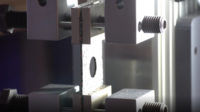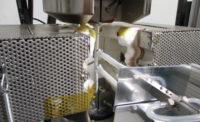The Future of Fatigue Testing
Experts discuss what’s next in fatigue testing in the automobile industry.

In a regulated consumer industry, it is vital to test everything from individual components and materials to major assemblies and crash structures. But while the automotive sector has specific requirements for testing materials and components, the principles of fatigue remains the same both across industries and within the scope of automobiles themselves.
Fatigue is anything that involves alternating, or cyclic, stress or strain, and this loading can cause damage or cracking at stresses that are well below the yield strength of the material or component, explains Element Engaged Expert Dr. John Tartaglia.
“We refer to cycles of 100 to 10,000 as low cycle fatigue (LCF), and more than 10,000 is referred to as high cycle fatigue (HCF),” he continues. “This can be significant given that cars, or their components, may well have many millions of cycles.
To gain insight into fatigue testing in the modern automotive industry, Quality talked more with Tartaglia, along with experts Alex Johnson, an applications engineer for Instron, and Steve Panter, chief engineer for the automotive Americas’ division of Exova Group.
QUALITY: What materials and parts are most commonly tested for fatigue in the auto sector?
JOHN TARTAGLIA: In terms of materials, the automotive sector primarily uses steel for structural parts, cast aluminum for cylinder blocks and heads, and cast iron for crankshafts. Aluminum is increasingly incorporated within the body panels and structural parts of vehicles. That said, larger vehicles such as trucks may make use of cast iron in parts such as heads and blocks, as a result of the loads and temperatures involved. Steel and aluminum are, however, increasingly formed in new ways: hydroforming to create tubular parts aims to reduce the weight of materials compared with older solid bar or plate structures.
For the purposes of fatigue testing, we can separate the uses of the materials into the structural parts of the vehicle and the powertrain. The structural part of the car includes center-pillars for doors and running boards. Other structural parts include frames, bumpers, brackets, engine cradles, seat parts, seat backs and wheels, all of which are tested at material and component level from the standpoint of vibration just as much as crash worthiness. Due to expense and complexity, heads and blocks are not usually fatigue tested; heads and blocks are usually fatigue tested with coupon samples, which are test specimens that have been excised and machined from the components. However, crankshafts and entire engines are still subjected to dynamometer testing with severe over-temperature and load conditions.
How does fatigue testing differ when testing different materials for instance, composites vs. metals?
TARTAGLIA: Within automotive manufacturing, polymer matrix composites (PMC) and carbon fiber reinforced polymers (CFRP) are used. Compared with metals, these materials provide interesting challenges for fatigue testing. From the standpoint of setting up the tests themselves, composite testing requires advanced machining techniques to avoid fiber pullout, sensitive load cells to measure low loads and advanced gripping techniques to avoid grip fractures that do not occur with metals.
Due to their anisotropic nature, PMCs present another challenge. The properties of these materials vary with direction, so lay-up techniques involving blanket methods are designed to remove the anisotropy. As a result, any fatigue testing requires consideration of the loading direction for lay-up structures.
Are there certain procedures or considerations that differentiate testing programs in the auto sector from other industries, such as aerospace?
STEVE PANTER: Testing differences range from loading magnitude, loading axis requirements, environmental conditions, testing methodology and documentation requirements. Also, the end-user service environment (duty cycle) needs to be considered for unique product exposure depending on the system application/requirements.
ALEX JOHNSON: The automotive sector has a greater emphasis on crash behavior and impact properties of materials with a need to simulate catastrophic failure. Other industries focus more on life expectancy under “normal” conditions. The market focuses heavily on product safety. Whether it’s a consumer vehicle, a commercial vehicle, or a high-performance sports vehicle, it needs to be able to protect its passengers in the event of impact. This is not to say that life expectancy testing isn’t considered, this testing is still relevant to validate the product durability to ensure their customers are receiving a reliable product.
Fatigue behavior allows manufacturers to better understand the lifetime of their product. In turn, this then allows for the marketing of extended warranty periods and how the product is supported in the future which can be a very powerful tool to differentiate from the competition. The use of electric powered automation has pushed manufacturers to look into the use of battery cells and lightweight materials to make cars more efficient and decrease their carbon footprint. The new components and materials now have to undergo durability testing to ensure they can be used to optimize performance whilst maintaining safety.
How has fatigue testing changed during the last 20 years?
JOHNSON: Understanding the life of materials has always been a vital part of the design and development processes within safety-critical industries and applications. With the ongoing pursuit for more fuel efficient and lighter weight materials and structures, there is a drive to push materials closer to their physical limits without compromising on safety. This, in combination with the advances in materials and manufacturing technology, has led to an increase in levels of empirical fatigue testing despite the increased use of modelling in the design process. The use of composites more widely in mass production applications is a great example of “designer” materials which are tweaked and optimized to suit their application. With so many variables in the manufacture of composites—resin choice, fiber structure and manufacturing processes—there has been a lot of research and testing carried out to find the optimum constructions for aerospace, automotive and wind power applications.
The use of materials with optimized characteristics to suit their loading becomes striking when you see that the blade of a wind turbine uses hundreds of different composite materials along its length, each one optimized for the forces and loading experienced by that part of the blade. With the increased use of sintering and 3D-printed technology, we see a similar trend in designer metal structures which are tailored to their application. A number of our customers are looking to significantly reduce the time taken to develop brand new alloys and material compounds and fatigue testing has a significant part to play in that process.
Are there future trends in materials, technology, methods or tools that will cause change?
TARTAGLIA: While the basic principles within fatigue testing have not changed in the last fifty years, specimen testing has certainly undergone a significant overhaul. Digitization of the test control and analytical data for strain life fatigue information has been the biggest change in fatigue testing.
A very significant development, which is gaining traction within the industry, is the increasing prevalence of “just-in-time” manufacturing methods. This has prompted manufacturers to assess how they can reduce the time taken in the fatigue testing stage. Naturally, long testing cycles require specific time frames, and accelerating fatigue test frequency will have consequences on the temperatures generated in the fatigue test sample, which may alter the results and conditions required.
Within the industry, the ultimate goal is to add very-high cycle fatigue (VHCF) tests to the current LCF/HCF testing, which will more accurately predict long-term fatigue life within the automotive sector. VHCF methods involve quite a radical re-think to fatigue testing. VHCF test development currently involves passing sound waves through samples, rather than current techniques applying fatigue strains to samples with moving servo-hydraulic actuators.
Another significant change we are working towards is the modeling of fatigue testing of materials. Models are predicted to introduce virtual casting and testing processes, which is a major change in the industry. These virtual processes will inevitably deliver significant savings on current physical metal processing and test methods, as certifying materials requires significant expense.
Life prediction is a big area of research, which will allow manufacturers to revise their processes to quickly deliver enhanced properties for materials and improved performance of their products and vehicles.
New manufacturing techniques, such as 3D printing, will present new challenges. Ultimately, we can’t accurately predict the huge range of fatigue resistance benefits (or perhaps disadvantages) from these materials at this stage. As we gather more information about their manufacture and performance, we will see an increase in their use.
JOHNSON: Composite materials of various sorts are going to be essential to the future of the automotive industry. That means that the state of standardization, as well as theory, needs to improve to properly address fatigue of all types of polymer matrix composite materials. Over recent years, we at Instron have worked on providing improved tools for composites fatigue testing, helping to extract extra data from each test, and adding control features which can manage those specimen temperature changes created by the act of performing a fatigue test.
The urgent need for automotive producers to reduce emissions is the ultimate business driver for the changes which are starting to take place, and although high technology options for power train efficiency have benefits, major savings can be made most easily by the “simple” expedient of reducing overall mass. As already mentioned, that can be achieved in some areas by moving to carbon fiber composites and similar materials, which brings with it some challenges for both measurement and design. Maybe less in the public eye, is the fact that the greatest commercial potential is in composite or hybrid structures, for example combining high strength metals in sheet-laminated forms, or pressed then over-molded with polymer compounds.
PANTER: The continued development of new high-strength steels and alloys, and the progress of 3D printing for material components, will need to be reviewed to ensure that the current and future fatigue requirements keep up with the technology. This also applies to the development of new composite materials and assembling techniques, including the advancement in fastening and adhesive technology.
Computer modelling advancements are providing more precise loading parameters for component and sub-system testing procedure designs. The development of noncontact, real-time (virtual) stress and strain measurement systems are also helping to understand load paths and allow new fatigue testing procedure/techniques to be developed.
Interviews were edited for length and clarity.
Looking for a reprint of this article?
From high-res PDFs to custom plaques, order your copy today!










